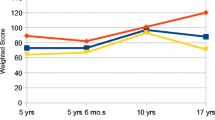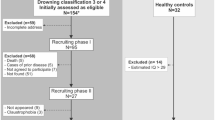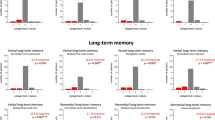Abstract
Memory deficits are the most common neuropsychological sequelae after brain affections. We report the case of a 54-year-old, male patient who, after a diffuse hypoxic brain damage due to cardiac decompensation, received various forms of supportive treatment. The primary aim of the treatment process, namely, to allow him to live on his own and be able to remember, to plan, and to execute his ideas came to fruition during a process of altogether 1.5 years.
Similar content being viewed by others
References
Auer, R. N., Jensen, M. L., and Whishaw, I. Q. (1989). Neurobehavioral deficit due to ischemic brain damage limited half of the CA1 sector of the hippocampus.J. Neurosci. 9: 1641–1647.
Ben-Yishay, Y., Rattock, J., and Diller, L. A. (1979). A remedial “module” for the systematic amelioration of basic attentional disturbances in head trauma patients. InWorking Approaches to Remediation of Cognitive Deficits in Brain Damaged Persons, New York University Medical Center, New York.
Ben-Yishay, Y., Rattock, J., Lakin, P., Piasetsky, E. B., Ross, B., Silver, S. Zide, E., and Ezrachi, O. (1985). Neuropsychological rehabilitation: Quest for a holistic approach.Sem. Neurol. 5: 252–259.
Ben-Yishay, Y., Silver, S. M., Plasetzky, E., and Rattock, J. (1987). Relationship between employability and vocational outcome after intensive holistic cognitive rehabilitation.J. Head Trauma Rehabil. 2: 35–48.
Berrol, S. (1990). Issues in cognitive rehabilitation.Arch. Neurol. 47: 219–220.
Boyeson, M. G., Jones, J. L., and Harmon, R. L. (1994). Sparing of motor function after cortical injury. A new perspective on underlying mechanisms.Arch. Neurol. 51: 405–414.
Brickenkamp, R. (1986).Handbuch apparativer Verfahren in der Psychologie, Hogrefe, Göttingen.
Calabrese, P., Fink, G. R., Markowitsch, H. J., Kessler, J., Durwen, H., Liess, J., Haupts, M., and Gehlen, W. (1994). Left hemispheric neuronal heterotopia. A PET, MRI, EEG, and neuropsychological investigation of a university student.Neurology 44: 302–305.
Carney, A. L., and Anderson, E. M. (eds.) (1981).Diagnosis and Treatment of Brain Ischemia. (Advances in Neurology Series, Vol. 30), Raven Press, New York.
Christensen, A.-L., Pinner, E., Moller-Pedersen, P., Teasdale, T. W., and Trexler, L. E. (1992). Psychosocial outcome following individualized neuropsychological rehabilitation of brain damage.Acta Neurol. Scand. 85: 32–38.
Crook, T. H., and Larrabee, G. J. (1990). A self-rating scale for evaluating memory in everyday life.Psychol. Aging 5: 48–47.
Crovitz, H. F., Habey, M. T., and Horn, R. W. (1979). Problems in the acquisition of imagery mnemonics: Three brain-damaged cases.Cortex 15: 225–234.
Dahl, G. (1972).WIP-Reduzierter Wechsler-Intelligenztes, Hain, Meisenheim am Glan.
Damasceno, B. P. (1991). Decerebrate rigidity with preserved cognition and gait: A possible role of anoxic-ischemic brain damage.Internat. J. Neurosci. 58: 283–287.
Deisinger, K., and Markowitsch, H. J. (1991). Die Wirksamkeit von Gedächtnistrainings in der Behandlung von Gedächtnisstörungen bei Hirngeschädigten.Psychol. Rdsch. 42: 55–65.
De Volder, A. G., Goffinet, A. M., Bol, A., Michel, C., de Barsy, T., and Laterre, C. (1990). Brain glucose metabolism in postanoxic syndrome. Positron emission tomographic study.Arch. Neurol. 47: 197–204.
Dobkin, B. H. (1990). Focused stroke rehabilitation programs do not improve outcome.Arch. Neurol. 46: 701–703.
Drühe, C.-M., and Hartje, W. (1989). Hypoxische Amnesie nach Herzstillstand. Neuropsychologische Fallstudie.Nervenarzt 60: 280–283.
Gentile, J. R., Roden, A. H., and Klein, R. D. (1972). An analysis-of-variance-model for the intrasubject replication design.J. Appl. Behav Anal. 5: 193–198.
Glisky, E. L. (1995). Acquisition and transfer of word processing skill by an amnesic patient.Neuropsychol. Rehab. 5: 299–318.
Growswasser, Z. (1994). Rehabilitating psychosocial functioning. In Christensen, A.-L., and Uzzell, B. P. (eds.),Brain Injury and Neuropsychological Rehabilitation, LEA, Hillsdale, NJ pp. 187–199.
Hanlon, R. E., Dobkin, B. H., Hadler, B., Ramirez, S., and Cheska, Y. (1992). Neurorehabiliation following right thalamic infarct: Effects of cognitive retraining on functional performance.J. Clin. Exp. Neuropsychol. 14: 433–447.
Hautzinger, M. (1991). Das Beck-Depressionsinventar in der Klinik.Nervenarzt 62: 689–696.
Herrmann, D., and Neisser, U. (1988). An inventory of everyday memory experiences. In Gruneberg, M. M., Morris, P.E., and Sykes, R. N. (eds.),Practical Aspects of Memory, Academic Press, London, pp. 134–177.
Levin, H. (1990). Cognitive rehabilitation: Unproved but promising.Arch. Neurol. 47:223–224.
Lezak, M. D. (1995).Neuropsychological Assessment, 3rd ed., Oxford University Press, New York.
Lienert, G. A. (1961).Testaufbau und Testanalyse, Beltz, Weinheim.
Markowitsch, H. J. (1995). Anatomical basis of memory disorders. In Gazzaniga, M. S. (ed.),The Cognitive Neurosciences, MIT Press, Cambridge, MA, pp. 765–779.
Markowitsch, H. J., von Cramon, D. Y., and Schuri, U. (1993). Mnestic performance profile of a bilateral diencephalic infarct patient with preserved intelligence and severe amnesic disturbances.J. Clin. Exp. Neuropsychol. 15: 627–652.
McMillan, T. M. (1984). Investigation of everyday memory in normal subjects using the Subjective Memory Questionnaire (SMQ).Cortex 20: 333–347.
Meier, M. J., Benton, A. L., and Diller, L. (eds.) (1987).Neuropsychological Rehabilitation, Guilford Press, New York.
Milders, M. V., Berg, I. J., and Deelman, B. G. (1995). Four-year follow-up of a controlled memory training study in closed head injured patients.Neuropsychol. Rehab 5: 223–238.
Ostrum, A. E. (1993). Brain injury: A personal view.J. Clin. Exp. Neuropsychol. 15: 623–624.
Parkin, A. J., Miller, J., and Vincent, R. (1987). Multiple neuropsychological deficits due to anoxic encephalopathy: A case study.Cortex 23: 655–665.
Petito, C. K., Feldmann, E., Pulsinelli, W. A., and Plum, F. (1987). Delayed hippocampal damage in humans following cardiorespiratory arrest.Neurology 37: 1281–1286.
Plum, F. C. (1973). The clinical problem: How much anoxia-ischemia damages the brain?Arch. Neurol. 29: 359–360.
Pommerenke, K., and Markowitsch, H. J. (1989). Rehabilitation training of homonymous visual field defects in patients with postgeniculate damage of the visual system.Restor. Neurol. Neurosci. 1: 47–63.
Press, G. A., Amaral, D. G., and Squire, L. R. (1989). Hippocampal abnormalities in amnesic patients revealed by high-resolution magnetic resonance imaging.Nature 341: 54–57.
Prigatano, G. P. (1986). The neuropsychological rehabilitation program at Presbyterian Hospital Oklahoma City. In Prigatano, G. P. (ed.),Neuropsychological Rehabilitation after Brain Injury, Johns Hopkins University Press, Baltimore, pp. 96–118.
Rey, A. (1964).L'examen clinique en psychologie, Presses universitaires de France, Paris.
Robinson, R. G., Kubos, K. L., Starr, L. B., Rao, K., and Price, T. R. (1984). Mood disorders in stroke patients.Brain 107: 81–93.
Sohlberg, M. M., and Mateer, C. A. (1989). Training use of compensatory memory books: A three stage behavioral approach.J. Clin. Exp. Neuropsychol. 11: 871–887.
Sparks, D. L., Hunsaker, J. C., III, Scheff, S. W., Kryscio, R. J., Henson, J. L., and Markesbery, W. R. (1990). Cortical senile plaques in coronary artery disease, aging and Alzheimer's disease.Neurobiol. Aging 11: 601–607.
Spreen, O., and Strauss, E. (1991).A Compendium of Neuropsychological Tests. Administration, Norms and Commentary, Oxford University Press, New York.
Steingass, H.-P., Bobring, K. H., Burgart, F., Sartory, G., and Schungens, M. (1994). Memory training in alcoholics.Neuropsychol. Rehab. 4: 49–62.
Sunderland, A., Harris, J. E. and Baddeley, A. D. (1983). Do laboratory tests predict everyday memory? A neuropsychological study.J. Verb. Lern Verb. Behav. 22: 341–357.
Thöne, A. I. T., and Markowitsch, H. J. (1996). How to teach amnesic patients new conceptual information. A comparison of different training procedures.J. Internat. Neuropsychol. Soc. (in press).
Trexler, L. E., Webb, P. M., and Zappala, G. (1994). Strategic aspects of neuropsychological rehabilitation. In Christensen, A.-L., and Uzzell, B. P. (eds.),Brain Injury and Neuropsychological Rehabilitation, Lawrence Erlbaum, Hillsdale, NJ, pp. 99–121.
Tulving, E. (1995). Organization of memory: Quo vadis? In Gazzaniga, M. S. (ed.),The Cognitive Neurosciences, MIT Press, Cambridge, MA, pp. 839–847.
Volpe, B. T., and McDowell, F. H. (1990). The efficacy of cognitive rehabilitation in patients with traumatic brain injury.Arch. Neurol. 47: 220–222.
Volpe, B. T., and Hirst, W. (1983) The characterization of an amnesic syndrome following hypoxic ischemic injury.Arch. Neurol. 40: 436–440.
Volpe, B. T., and Petito, C. K. (1985). Dementia with bilateral medial temporal lobe ischemia.Neurology 35: 1793–1797.
Volpe, B. T., Holtzman, J. D., and Hirst, W. (1986). Further characterization of patients with amnesia after cardiac arrest: Preserved recognition memory.Neurology 36: 408–411.
Wilson, B., Cockburn, J., and Baddeley, A. (1984).The Rivermead Behavioural Memory Test, Thames Valley Test Company, Reading.
Zencius, A., Wesolowski, M. D., Krankowski, T., and Burke, W. H. (1991). Memory notebook training with traumatically brain-injured clients.Brain Injury 5: 321–325.
Zola-Morgan, S., Squire, L. R., and Amaral, D. G. (1986). Human amnesia and the medial temporal region: Enduring memory impairment following a bilateral lesion limited to field CA1 of the hippocampus.J. Neurosci. 6: 2950–2967.
Author information
Authors and Affiliations
Rights and permissions
About this article
Cite this article
Calabrese, P., Markowitsch, H.J. Recovery of mnestic functions after hypoxic brain damage. Int J Rehab Health 1, 247–260 (1995). https://doi.org/10.1007/BF02214643
Issue Date:
DOI: https://doi.org/10.1007/BF02214643




